National Institute on Aging-Alzheimer's Association guidelines for the neuropathologic assessment of Alzheimer's disease: a practical approach
- PMID: 22101365
- PMCID: PMC3268003
- DOI: 10.1007/s00401-011-0910-3
National Institute on Aging-Alzheimer's Association guidelines for the neuropathologic assessment of Alzheimer's disease: a practical approach
Abstract
We present a practical guide for the implementation of recently revised National Institute on Aging-Alzheimer's Association guidelines for the neuropathologic assessment of Alzheimer's disease (AD). Major revisions from previous consensus criteria are: (1) recognition that AD neuropathologic changes may occur in the apparent absence of cognitive impairment, (2) an "ABC" score for AD neuropathologic change that incorporates histopathologic assessments of amyloid β deposits (A), staging of neurofibrillary tangles (B), and scoring of neuritic plaques (C), and (3) more detailed approaches for assessing commonly co-morbid conditions such as Lewy body disease, vascular brain injury, hippocampal sclerosis, and TAR DNA binding protein (TDP)-43 immunoreactive inclusions. Recommendations also are made for the minimum sampling of brain, preferred staining methods with acceptable alternatives, reporting of results, and clinico-pathologic correlations.
Figures
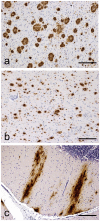
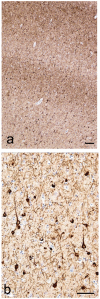

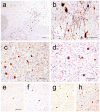
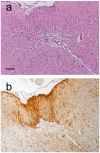
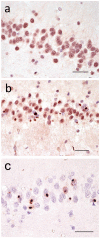
Similar articles
-
National Institute on Aging-Alzheimer's Association guidelines for the neuropathologic assessment of Alzheimer's disease.Alzheimers Dement. 2012 Jan;8(1):1-13. doi: 10.1016/j.jalz.2011.10.007. Alzheimers Dement. 2012. PMID: 22265587 Free PMC article.
-
Genome-wide association meta-analysis of neuropathologic features of Alzheimer's disease and related dementias.PLoS Genet. 2014 Sep 4;10(9):e1004606. doi: 10.1371/journal.pgen.1004606. eCollection 2014 Sep. PLoS Genet. 2014. PMID: 25188341 Free PMC article.
-
Revised criteria for diagnosis and staging of Alzheimer's disease: Alzheimer's Association Workgroup.Alzheimers Dement. 2024 Aug;20(8):5143-5169. doi: 10.1002/alz.13859. Epub 2024 Jun 27. Alzheimers Dement. 2024. PMID: 38934362 Free PMC article.
-
NIA-AA Research Framework: Toward a biological definition of Alzheimer's disease.Alzheimers Dement. 2018 Apr;14(4):535-562. doi: 10.1016/j.jalz.2018.02.018. Alzheimers Dement. 2018. PMID: 29653606 Free PMC article. Review.
-
Correlation of Alzheimer Disease Neuropathologic Staging with Amyloid and Tau Scintigraphic Imaging Biomarkers.J Nucl Med. 2020 Oct;61(10):1413-1418. doi: 10.2967/jnumed.119.230458. Epub 2020 Aug 6. J Nucl Med. 2020. PMID: 32764121 Review.
Cited by
-
Association of quantitative histopathology measurements with antemortem medial temporal lobe cortical thickness in the Alzheimer's disease continuum.Acta Neuropathol. 2024 Sep 3;148(1):37. doi: 10.1007/s00401-024-02789-9. Acta Neuropathol. 2024. PMID: 39227502 Free PMC article.
-
Comparison of regional flortaucipir PET with quantitative tau immunohistochemistry in three subjects with Alzheimer's disease pathology: a clinicopathological study.EJNMMI Res. 2020 Jun 15;10(1):65. doi: 10.1186/s13550-020-00653-x. EJNMMI Res. 2020. PMID: 32542468 Free PMC article.
-
Pathological tau deposition in Motor Neurone Disease and frontotemporal lobar degeneration associated with TDP-43 proteinopathy.Acta Neuropathol Commun. 2016 Mar 31;4:33. doi: 10.1186/s40478-016-0301-z. Acta Neuropathol Commun. 2016. PMID: 27036121 Free PMC article.
-
Systemic infection exacerbates cerebrovascular dysfunction in Alzheimer's disease.Brain. 2021 Jul 28;144(6):1869-1883. doi: 10.1093/brain/awab094. Brain. 2021. PMID: 33723589 Free PMC article.
-
Discriminative and prognostic potential of cerebrospinal fluid phosphoTau/tau ratio and neurofilaments for frontotemporal dementia subtypes.Alzheimers Dement (Amst). 2015 Dec 14;1(4):505-12. doi: 10.1016/j.dadm.2015.11.001. eCollection 2015 Dec. Alzheimers Dement (Amst). 2015. PMID: 27239528 Free PMC article.
References
-
- Alafuzoff I, Parkkinen L, Al-Sarraj S, et al. Assessment of alpha-synuclein pathology: a study of the BrainNet Europe Consortium. J Neuropathol Exp Neurol. 2008;67:125–43. - PubMed
-
- Alafuzoff I, Pikkarainen M, Al-Sarraj S, et al. Interlaboratory comparison of assessments of Alzheimer disease-related lesions: a study of the BrainNet Europe Consortium. J Neuropathol Exp Neurol. 2006;65:740–57. - PubMed
Publication types
MeSH terms
Substances
Grants and funding
- P30 AG013854/AG/NIA NIH HHS/United States
- AG05131/AG/NIA NIH HHS/United States
- AG28383/AG/NIA NIH HHS/United States
- AG19610/AG/NIA NIH HHS/United States
- P50 AG005681-28/AG/NIA NIH HHS/United States
- U19 AG024904/AG/NIA NIH HHS/United States
- AG12435/AG/NIA NIH HHS/United States
- P30 AG019610/AG/NIA NIH HHS/United States
- AG05134/AG/NIA NIH HHS/United States
- P50 AG005136-29/AG/NIA NIH HHS/United States
- P30 AG010124/AG/NIA NIH HHS/United States
- R01 AG042210/AG/NIA NIH HHS/United States
- RF1 AG015819/AG/NIA NIH HHS/United States
- P30 AG019610-08/AG/NIA NIH HHS/United States
- AG17917/AG/NIA NIH HHS/United States
- AG10124/AG/NIA NIH HHS/United States
- P50 AG005131/AG/NIA NIH HHS/United States
- P30 AG062421/AG/NIA NIH HHS/United States
- R01 AG015819-12/AG/NIA NIH HHS/United States
- U01 AG024904/AG/NIA NIH HHS/United States
- AG15866/AG/NIA NIH HHS/United States
- R01 AG018440-05/AG/NIA NIH HHS/United States
- U19 AG010483/AG/NIA NIH HHS/United States
- AG03991/AG/NIA NIH HHS/United States
- U01 AG016976/AG/NIA NIH HHS/United States
- U01 AG016976-09/AG/NIA NIH HHS/United States
- P01 AG003991/AG/NIA NIH HHS/United States
- P50 AG005681/AG/NIA NIH HHS/United States
- AG16570/AG/NIA NIH HHS/United States
- AG18840/AG/NIA NIH HHS/United States
- P30 AG013854-10/AG/NIA NIH HHS/United States
- R01 AG017917/AG/NIA NIH HHS/United States
- P50 AG016570-12/AG/NIA NIH HHS/United States
- R01 AG015866/AG/NIA NIH HHS/United States
- P50 AG005136/AG/NIA NIH HHS/United States
- P50 AG005134-24/AG/NIA NIH HHS/United States
- P30 AG028383-07/AG/NIA NIH HHS/United States
- AG24904/AG/NIA NIH HHS/United States
- P50 AG005131-21/AG/NIA NIH HHS/United States
- P50 AG016570/AG/NIA NIH HHS/United States
- P50 AG005134/AG/NIA NIH HHS/United States
- AG15819/AG/NIA NIH HHS/United States
- P01 AG012435-15/AG/NIA NIH HHS/United States
- P30 AG010161/AG/NIA NIH HHS/United States
- R01 AG018440/AG/NIA NIH HHS/United States
- P01 AG012435/AG/NIA NIH HHS/United States
- AG05681/AG/NIA NIH HHS/United States
- NS62684/NS/NINDS NIH HHS/United States
- P50 NS062684/NS/NINDS NIH HHS/United States
- U01 AG024904-07/AG/NIA NIH HHS/United States
- AG05136/AG/NIA NIH HHS/United States
- AG10161/AG/NIA NIH HHS/United States
- AG13854/AG/NIA NIH HHS/United States
- P50 NS062684-04/NS/NINDS NIH HHS/United States
- P01 AG003949/AG/NIA NIH HHS/United States
- P01 AG003991-27/AG/NIA NIH HHS/United States
- AG016976/AG/NIA NIH HHS/United States
- P30 AG010161-19/AG/NIA NIH HHS/United States
- P30 AG028383/AG/NIA NIH HHS/United States
- R01 AG015866-10/AG/NIA NIH HHS/United States
- R01 AG015819/AG/NIA NIH HHS/United States
LinkOut - more resources
Full Text Sources
Other Literature Sources
Medical

